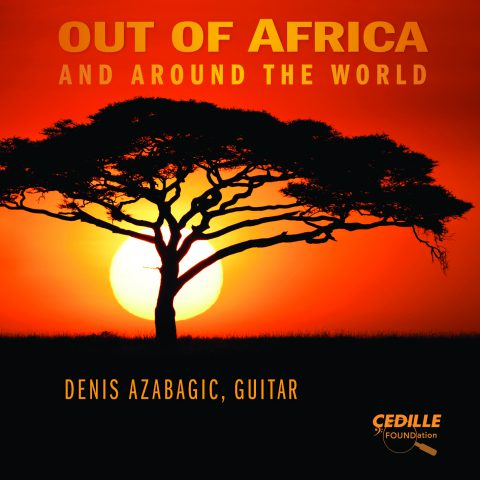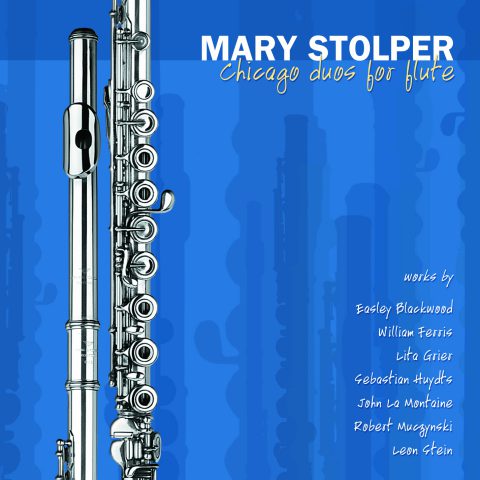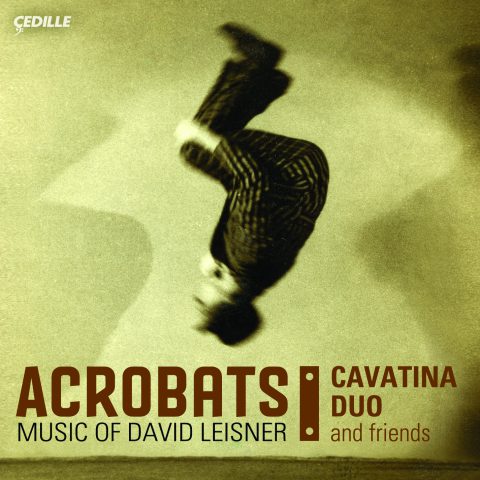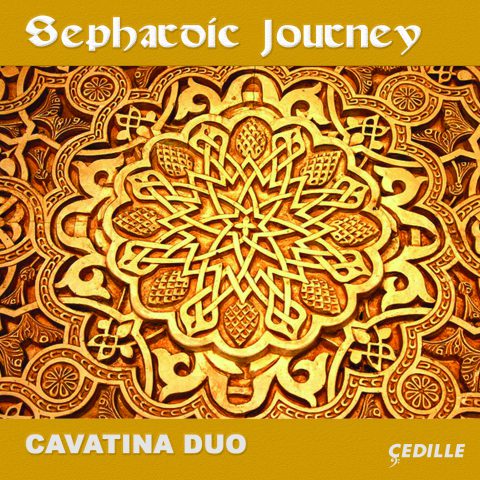Store
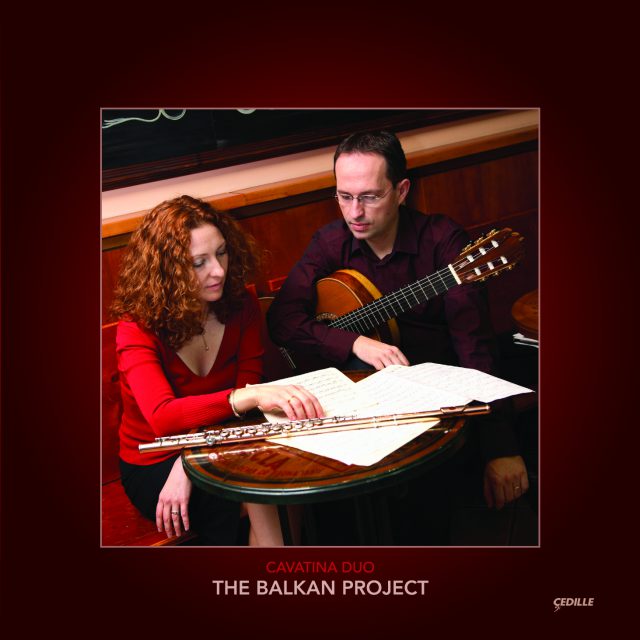
The Cavatina Duo, “excellent instrumentalists and sensitive musicians” (Sequenza21.com), has captivated concert audiences worldwide with their enchanting blend of Spanish passion and Balkan sensibility.
On The Balkan Project, their second and newest Cedille Records CD, Spanish-born flutist Eugenia Moliner and Bosnian-born guitarist Denis Azabagic expand the boundaries of flute and guitar music with a program of more than a dozen works inspired by traditional Balkan folk songs and dances. Nine of the compositions were commissioned by and dedicated to the Cavatina Duo and are world-premiere recordings.
Looking at the culturally rich crossroads of civilization that are the Balkans, ten contemporary composers have chosen, as their points of departure, music from Serbia, Bosnia, Macedonia, Bugaria, and Croatia reflecting the region’s distinctive harmonic, melodic, and rhythmic signatures.
“Each piece goes far beyond mere quotation of a melody or a form to reveal the true essence of the source material,” writes Bosnian composer Vojislav Ivanovic in the CD booklet notes. “All the works on this disc also beautifully exploit the timbres and technical possibilities of the guitar and flute to provide a vehicle for the extraordinary artistry of Denis and Eugenia.”
The Cavatina was the first flute and guitar duo to grace the cover of England’s Classic Guitar magazine and has been featured in Guitarra Magazine on the Web, in Soundboard magazine in the U.S., and elsewhere.
In a review of the ensemble’s Cedille Records debut, Acrobats: Music of David Leisner, American Record Guide said, “The playing is spectacular!” Fanfare magazine echoed that assessment: “it’s doubtful that the Cavatina’s sophisticated and artistic playing could be surpassed.” Pan, the British Flute Society magazine, praised Moliner as “an excellent, exciting and imaginative flute player” and said Azabagic “plays with both great virtuosity and sensitivity.
Preview Excerpts
CARLOS RAFAEL RIVERA (b. 1970)
VOJISLAV IVANOVIC (b. 1959)
MATTHEW DUNNE (b. 1959)
CLARICE ASSAD (b. 1978)
DENIS SPARAVALO (b. 1972)
ALAN THOMAS (b. 1968)
MICHAEL KARMON (b. 1969)
CLARICE ASSAD
BORIS GAQUERE (b. 1977)
ALAN THOMAS
MIROSLAV TADIC (b. 1958)
Four Macedonian Pieces
from his Four Legends
CLARICE ASSAD
Artists
Program Notes
Download Album BookletThe Balkan Project
Notes by Vojislav Ivanovic
There is perhaps no place on earth where more very different cultures, languages, religions, and civilizations meet and closely interact than the Balkans.
Nowadays referred to as “Southeastern” Europe, “the Balkans” comprise not only the Balkan Peninsula, but also the larger area incorporating present day Greece, Macedonia (Fyrom), Albania, Bulgaria, Serbia, Montenegro, Bosnia and Herzegovina, and Croatia, as well as some parts of Turkey and Romania. It takes its name from the Balkan Mountains that run through Bulgaria and Serbia. “Balkan” is Turkish for “a chain of wooded mountains.” It has always been, and remains today, the dividing line between East and West. A poet once called it “the house made in the middle of the road,” and what a busy road that was!
In its tormented history, it has been torn by endless wars, and political and religious conflicts, but it has also been an exciting crossroad of civilizations out of which a definable Balkan spirit and identity emerged.
Nowhere is that spirit expressed better than in music: Fast songs with rhythms that make your body move with almost uncontrolled passion, melancholy songs that inspire deep contemplation, and love songs — so often wrapped in hidden messages — that touch the very essence of the soul.
The influences that have shaped Balkan music are myriad. First, ancient Greek musical theory and practice, which laid the foundation for the world’s dominant musical language through its modes-scales: The Ionian and Aeolian modes became the West’s Major and Minor scales. Different Greek modes — Dorian, Phrygian, Lydian and others — influenced Byzantine sacred and secular music, forming very differently “tuned” scales which, in turn, influenced Arabic and (later) Ottoman Turkish music — both “classical” and “folk.” Pagan Slavs brought their own coarse, northern rhythms and often pentatonic melodies. And then there are the mighty Gypsies, the Troubadours of the Balkans. Originating from India, theirs is a nation without a state or written history, but prone to being musicians and entertainers who act as the glue for this seemingly incongruent clash of civilizations. Ever traveling, they adopted, modified, and dispersed music from all over the area, creating a new style.
In recent times, the influence of Western music has become much stronger. So with few exceptions (in countries where small bands still cultivate performance on old instruments using old scales) the predominant harmonic language is Western. But many facets of today’s Balkan music, including some harmonic traits, are still peculiar to this region: unresolved tension in the form of melodies ending on the second degree of the scale harmonized with primary and secondary dominants; singing in parallel seconds; and the “deaf” dance — dancing with rhythm only, no melody at all. Melodically, there is the melancholic “Balkan Minor” — Dorian scale with the fourth step augmented — and the “Hitzaz,” the fifth mode of the harmonic minor. But the most exciting characteristic of Balkan music, its true trademark, is the rhythm, in particular odd meters usually employed in fast tempos. Most commonly heard are 7/8 and 9/8, but 5/8 and 11/8 also make frequent appearances, and even more unusual meters such as 15/8, 21/8, and 25/8 are sometimes featured.
Finally, the New Age of globalization and the success of some films and musicians brought worldwide attention to the music of the Balkans. People around the globe began listening to, appreciating, and even playing Balkan music — so much so that it is now a well recognized part of the world’s musical heritage.
This CD is offers a particularly fine example of that recognition. It is a collaboration of two superb musicians, one Balkan (Denis Azabagic is Bosnian), one not (Eugenia Moliner is of Spanish origin), with a wide variety of composers, most of whom are not from the Balkans. The music on this CD, most of which was commissioned by the Cavatina Duo, consists of arrangements of Balkan songs and dances. (Not all Balkan countries are included but the material chosen offers a fine specimen of this region’s beautiful traditional music.) And these are no ordinary arrangements! Each piece goes far beyond mere quotation of a melody or a form to reveal the true essence of the source material. (In most cases, the title “Impression on [name of traditional song or dance]” would be appropriate.) All the works on this disc also beautifully exploit the timbres and technical possibilities of the guitar and flute to provide a vehicle for the extraordinary artistry of Denis and Eugenia.
1 Vranjanski Cocek / Raven Dance
(Serbian song)
Composition by Carlos Rafael Rivera (b. 1970)
Commissioned by and dedicated to the Cavatina Duo
A typical party or wedding dance of south Serbia, the “Cocek” is a feast of dancing and life-joy celebration. It can be in a fast 2/4 meter with a rhumba-like rhythm or, as in this case, in a very fast 9/8. Executed in an open circle, this fast step dance from the Serbian region of Vranje explodes into a pulsating whirl of sound, motion, and vibrant color. The arrangement, which the composer titles “Raven Dance,” follows the structure of the original Serbian dance and emphasizes the virtuosic possibilities of both instruments.
2 Kad ja podjoh na Bembašu
(Bosnian song)
Composition by Vojislav Ivanovic (b. 1959)
Commissioned by and dedicated to the Cavatina Duo
This old traditional song, one of the most famous in Bosnia, is actually a Sephardic melody. When the Jews were persecuted and chased out of Spain and Portugal by the Inquisition, many fled to the Ottoman Empire, specifically, in this case, to the Balkans. They brought their cultural heritage with them, and this is one example of its beautiful mixture with the local culture.
The song “Kad ja pdjoh na Bembašu” is one of Bosnia’s most popular sevdalinkas. “Sevdalinka” is a song of “Sevdah” — love, longing, and passion. This song tells about a famous place in Sarajevo, Bentbaša, often pronounced “Bembaša” in songs and other colloquial settings. The name comes from a Turkish word meaning dam. From 1462 to 1875 there was a dam in Miljacka River, in the vicinity of the Šeher-?ehaja’s bridge, which was built by Isa-beg Ishakovic, the founder of Sarajevo. The original melody for this piece was most likely a spiritual Sephardic song that is still sometimes performed (although some believe the song really comes from the Turkish military march “Vatan Mar?i” composed by Rif’at Bey in 1877). This popular sevdalinka was performed in the German film Die Letze Brücke (The Letze Bridge), which strongly influenced the spread of its popularity.
The arrangement explores and exploits this passionate melody, which is, uncharacteristically, in a 3/4 waltz-like meter. The melody and harmony are transformed but occasionally emerge suddenly in their original form, sometimes in distant tonalities.
3 Eleno, Kerko Eleno
(Macedonian song)
Composition by Matthew Dunne (b. 1959)
Commissioned by and dedicated to the Cavatina Duo
“Eleno, Kerko Eleno” (Helen, my daughter!) is a classic Macedonian love song in a medium fast 7/8 meter, with western influenced melody and harmony. Elena’s mother asks why she is so thoughtful and what she is writing. Elena replies that it is a letter to her beloved who is in Edrene (Turkey) and she is assembling a list of the gifts she would like him to bring her. Dunne’s skilful arrangement plays with the melody and harmony of the song, avoiding direct quotation. Only late in the piece is the melody heard in its entirety, richly reharmonized. Matthew Dunne writes:
“My arrangement of the beautiful Macedonian folk song ‘Eleno, Kerko Eleno’ for the spectacular Cavatina Duo begins with a reflective guitar introduction that is based on fragments from the song’s melody. The rhythm is free, although set in the song’s 7/8 meter, and the harmony is a little jazz-influenced. Eventually the guitar settles into a sort of modified milonga rhythm, and the flute enters with a variation on the song. The two instruments interact within the 7/8 milonga setting including a bit of flamenco influence (a nod to Eugenia’s Spanish heritage?), joining together at the end to present the song’s complete melody for the first time.”
4 Kalajdzisko Oro
(Macedonian dance)
Composition by Clarice Assad (b. 1978)
Commissioned by and dedicated to the Cavatina Duo
Kalajdzisko Oro literally means “The Tin Smith’s dance.” An “Oro” (from Greek: “Choros” — dance), or elsewhere-named “Kolo” (round-dance), is a village dance with complex rhythms and harmonies. This particular dance comes from the area of Macedonia (formerly in Yugoslavia), but these ancient dances originated in Greece and date back more than two millennia. Kalajdzisko Oro is one of the most popular dances in a brisk 11/8 (4+3+4) meter and has been an inspiration for numerous arrangements and compositions. The arrangement by Clarice Assad impresses with its tasteful, superimposed harmonies and sprightly, almost flying dance feeling.
5 Psevdah No.2 / Clear Water
(Bosnian song)
Denis Sparavalo (b. 1972)
This piece is inspired not only by a particular song (Clear Water) but also by a common feeling of melancholy expressed in all of Bosnian traditional music called Sevdah (songs about love and passion). The title presents a fusion of two words: Psevdo (from psevdos, meaning false) and Sevdah. The piece also evokes the composer’s deep sadness during the Bosnian war when he lived and worked in Sarajevo. Despite the title, it is not a false Sevdah for in a beautiful, plaintive recitative it challenges the melancholic melodies with modern musical expressive means.
6 Sivi grivi (Bulgarian dance)
Composition by Alan Thomas (b. 1968)
Commissioned by and dedicated to the Cavatina Duo
“Sivi grivi is based on a dance from the Pirin region of Bulgaria. Typical of the region, the piece employs an asymmetrical meter (7/8) and has a largely stepwise diatonic melody featuring the exotic-sounding augmented 2nd interval. The piece is dedicated, with great admiration, to the Cavatina Duo.” (Alan Thomas)
As with most of the pieces on the CD, this is more an impression of a folk song than a simple arrangement. Thomas’s piece employs rich harmonies based on both standard modes and the Balkan minor, and ends on a dominant device typical of the folk music of neighboring Serbia.
7 Jovano Jovanke
(Macedonian folk song)
Composition by Michael Karmon (b. 1969)
Commissioned by and dedicated to the Cavatina Duo
A popular traditional folk song of the Macedonia region, this is frequently performed in the Republics of Macedonia, Bulgaria, and Serbia, and in Greece. It is about two young lovers separated by their disapproving parents. The song mentions the Vardar river which runs through the present-day Republic of Macedonia and Greece. The 7/8 meter of this song may be the most popular metrical pattern in Balkan music. In this arrangement, the original, evocative melody becomes a starting point for a deeper exploration of melodic and harmonic context in which newly composed material is interspersed with quotations of the original melody.
8 Ajde slusaj kalesh bre Andjo
(Listen to me, Andjo)
(Macedonian folk song)
Composition by Clarice Assad
Commissioned by and dedicated to the Cavatina Duo
This song, dating from the Ottoman Empire period, speaks of a Christian girl who chooses death rather than marry a Turkish aristocrat and convert to Islam. Her name was Kalesh Andja. The text of the song is structured as a dialog between Andja and the aristocrat. This beautiful modal-pentatonic melody is in a free rhythm echoing the inflexions of speech. The tune is reminiscent of “Amazing Grace,” demonstrating how widely dispersed the pentatonic scale is among nations worldwide. The arrangement follows the inner drama of the protagonists and brings out the melody in its full glory after a slow introduction.
9 Kopanitsa da Kalantchatska
(Bulgarian dance)
Composition by Boris Gaquere (b. 1977)
Commissioned by and dedicated to the Cavatina Duo
Kopanitsa (called Gankino in some regions) is the name for a family of lively folk dances from western Bulgaria written in 11/8 meter. Some dancers count the steps in terms of “quick” and “slow” beats, the pattern being quick-quick-slow-quick-quick (counted as 2-2-3-2-2). The name comes from the verb kopam, meaning “to dig” or “to hoe,” so it is sometimes translated as “little digging dance.”
Kopanitsas and gankinos are line dances which the dancers perform in a curved, inward-facing line, either holding hands with arms down or (in kopanitsas) holding the belts of the neighboring dancers. Dancers repeat one pattern until the leader on the right end of the line calls another pattern, so many of them are labeled called dances. This arrangement is characteristically Balkan in its use of 11/8 meter, its melodic motion in parallel sixths, and its skillful exploitation of the guitar’s percussive possibilities.
10 The Shepherd’s Dream (Croatian song)
Composition by Alan Thomas
Alan Thomas writes:
“While perusing a folksong collection, I came across a little tune labeled ‘Croatian Love Song.’ Though only eight bars long and extremely simple in its rhythmic and melodic construction, I became somewhat obsessed by the haunting beauty of this melody. I am often troubled by these ‘earworms’ (as the Germans call them), which in many cases I can only expel by writing a piece using the tune. In any case, as I sang the melody over and over in my mind, an image began to form of a shepherd on a hillside in the still evening air, playing variations on the melody as he drifted off to sleep. The score is headed with an excerpt from a poem by W.B. Yeats: ‘And I dreamed my lost love came stealthily out of the wood/With her cloud-pale eyelids falling on dream-dimmed eyes.'”
Thomas’s masterful handling of this little tune beautifully reveals the timbres of both flute and guitar. It is based on a typical pentatonic melody of Prekomurje (the region of Croatia beyond the river Mura). Like most Croatian folk songs, it is closer to the musical language of middle Europe than that of other Balkan music.
Four Macedonian Pieces
11 Jovka Kumanovka (song)
12 Zajdi, Zajdi (song)
13 Gajdarsko Oro (dance)
14 Pajdushko (dance)
Arranged for alto flute and guitar
Macedonia has a rich cultural heritage in art, architecture, poetry, and music. Tadic captures the essence of its folklore in these pieces. This music weaves together a mixture of multiple styles, from Turkish, Albanian, Roma (Gypsy), and other ethnic Balkan musical idioms. Local dances are called “oro.”
Macedonian folk songs are often historical in nature, with lyrics detailing great heroes and warriors. Love songs and shepherd songs, such as “Zajdi, Zajdi,” are also common. “Jovka Kumanovka” (Jovka-girl from Kumanovo, Macedonian city on the border with Serbia) is a song with a beautiful, haunting modal melody in a slow 7/8 meter. It has been an inspiration for generations and has been used almost as a “standard” by jazz musicians in the Balkans. Tadic’s arrangement goes beyond the tonal and structural qualities of the song in a simple yet imaginative way. Especially interesting is the imitation by both instruments of locally-characteristic vocal ornamen-tation, (not easy to obtain on the guitar), whein the voice is suddenly raised in a falsetto resembling a sigh or even crying, not unlike the manner of some American country singers.
“Zajdi, Zajdi”: This almost legendary song of the Balkans, particularly in the countries of the former Yugoslavia, is a slow free recitative, with richly ornamented modal melodies and characteristic major-minor ambiguity. It is the lament of a shepherd who orders the sun to go down, and calls for the Mountain-sister to drown in darkness. Then he speaks to the mountain, bemoaning that while its leaves, which go yellow in the autumn, turn green again every spring, his own youth, alas, can never return. The arrangement beautifully conveys the atmosphere of the song, building on the melody and harmony with small but subtle changes that give the piece a fresh new dimension.
Gajdarsko Oro: This fast, frantic dance in 12/8 meter (which can be counted as 4/4 with triplets) is found mainly in Bulgaria and Macedonia. It has a somewhat richer harmonic development still along the lines of modal-Hitzaz turnarounds. The arrangement is a model of superb instrumental writing — pure joy for both performer and listener.
Pajdushka is a sprightly dance in a lively 5/8 meter. Its modal melody is interspersed with a section in the Hitzaz scale before it returns to aeolian mode. The arrangement follows, simply and efficently, the almost intoxicating repetitive rhytmic flow so typical of these dances in which participants can continue to the point of complete exaustion.
15 Makedonski pesen (Macedonian song)
(from his Four Legends)
Composition by Atanas Ourkouzounov (b. 1970)
This beautiful piece is based on a guitar ostinato in a slow 6/4 (12/8) meter, organized in an ever repeating syncopated pattern of 4/4 + 2/4. The harmonies are Balkan but subtly enriched with jazzy extensions. Above this, the flute sings an elegiac melody of rare beauty as the piece perfectly exploits the expressive potential of both instruments.
bq Rachenitsa (Bulgarian Folk Dance)
Composition by Clarice Assad
Commissioned by and dedicated to the Cavatina Duo
A Rachenitsa is a dance in which the leader (if danced in a line) or the individuals (if danced as a solo/couple dance) may hold a handkerchief in one hand while dancing. It’s from the Thracian area of Bulgaria originally, but has become a sort of national folk dance. Bulgarian dances are particularly rich in the use of odd meters. This Rachenitsa has an opening statement in 9/8+7/8+11/8 that is beautifully exploited and varied over the course of the piece. Melody and harmony — basically modal, including the “Hitzaz” mode — are merged and enriched with Western elements in a delightfully effervescent manner.
Guitarrist/composer Vojislav Ivanovic is a graduate of the Athens Conservatory and received his masters degree from the Music Academy in Sarajevo. He has written for solo instruments, chamber ensembles, and orchestras; concertos for guitar and piano; and film and theatre music. Some of his guitar compositions have become part of the standard repertoire for the instrument. Vojislav Ivanovic is also Denis Azabagic’s former teacher.
Album Details
Total Time: 66:30
Producer: Jim Ginsburg
Engineer: Bill Maylone
Art Direction: Adam Fleishman — www.adamfleishman.com
Cover Photo: Yolanda Camarillas, Burriana, Spain
Recorded: December 17 and 18, 2008, and June 29, 2009, in the Fay and Daniel Levin Performance Studio at WFMT, Chicago
© 2010 Cedille Records/Cedille Chicago
CDR 90000 117
